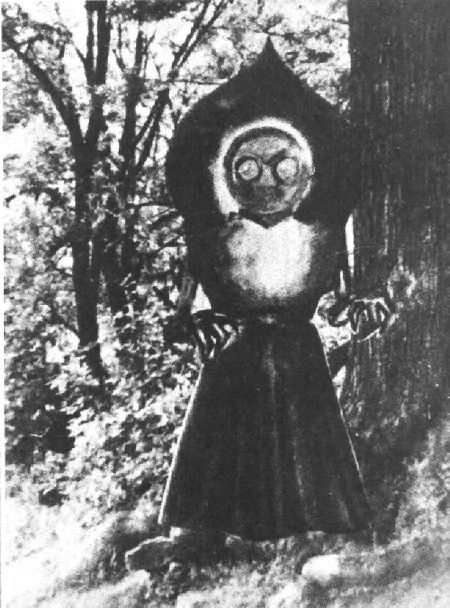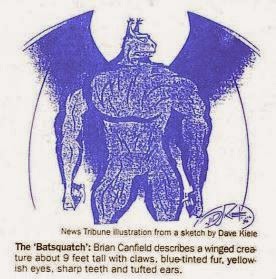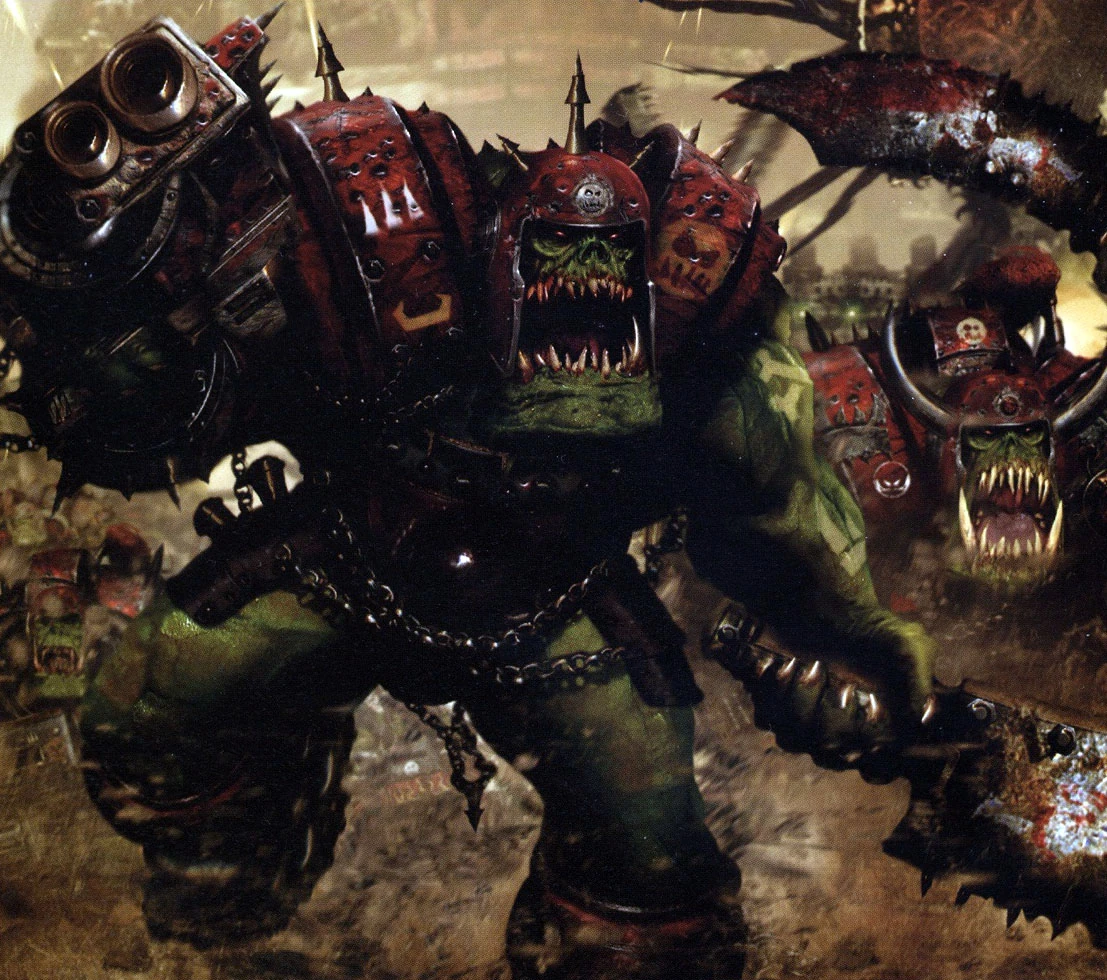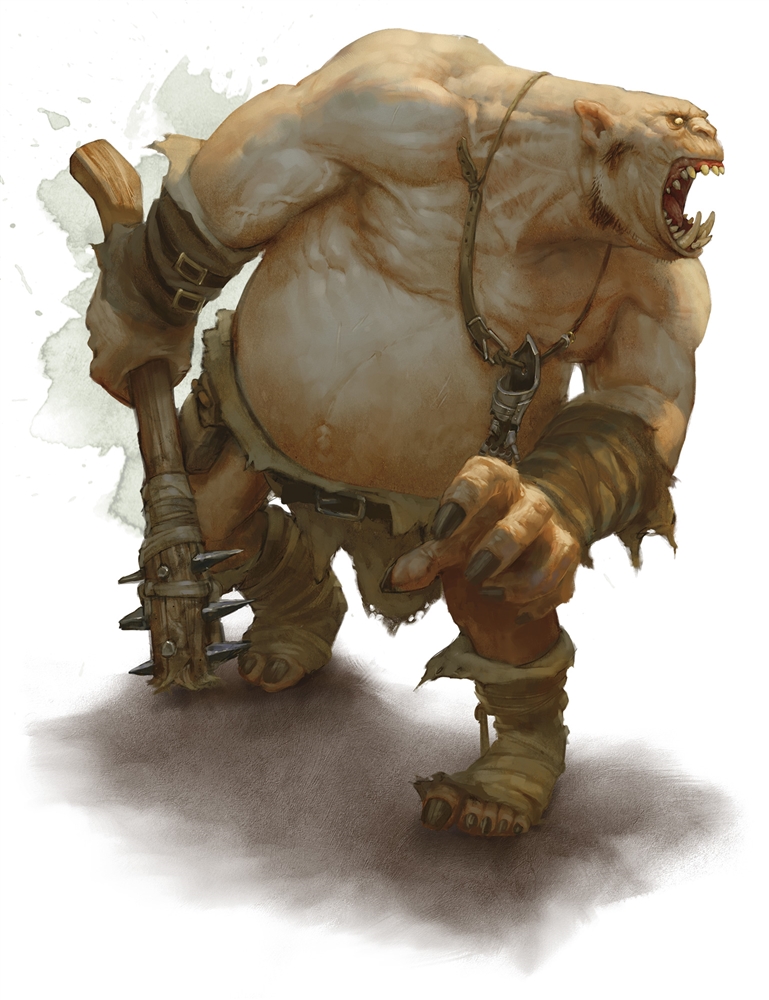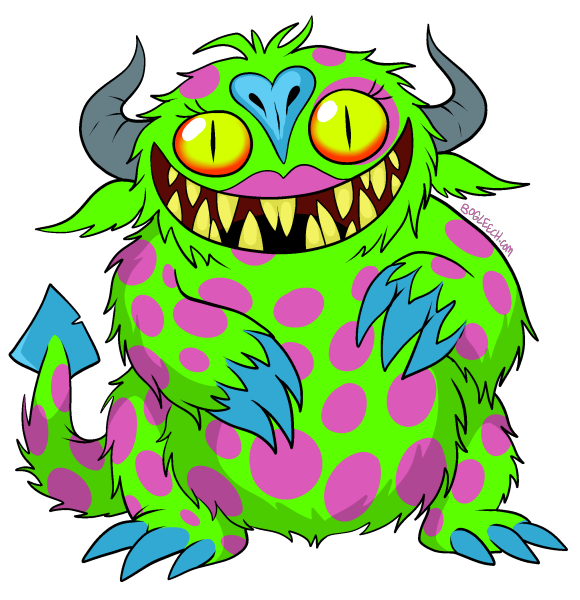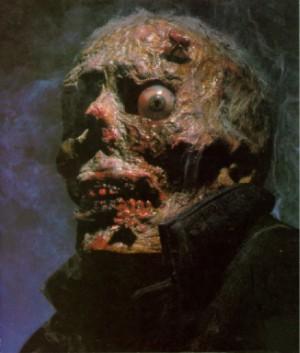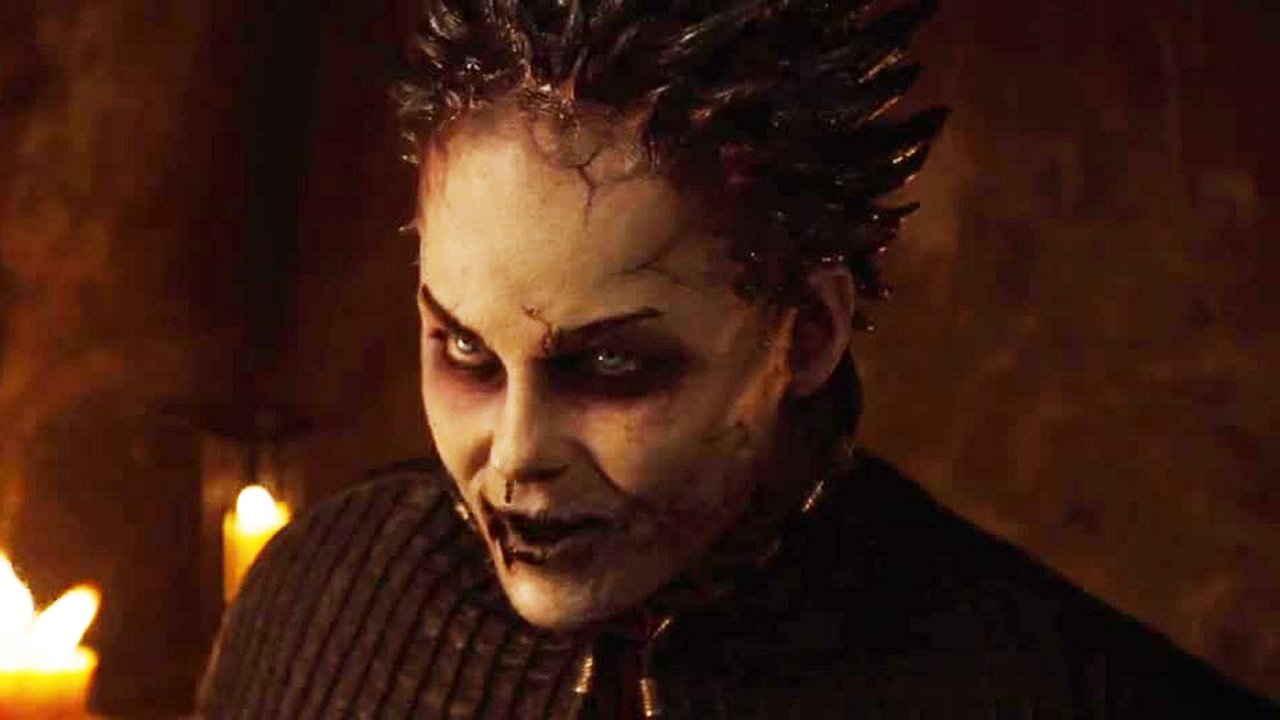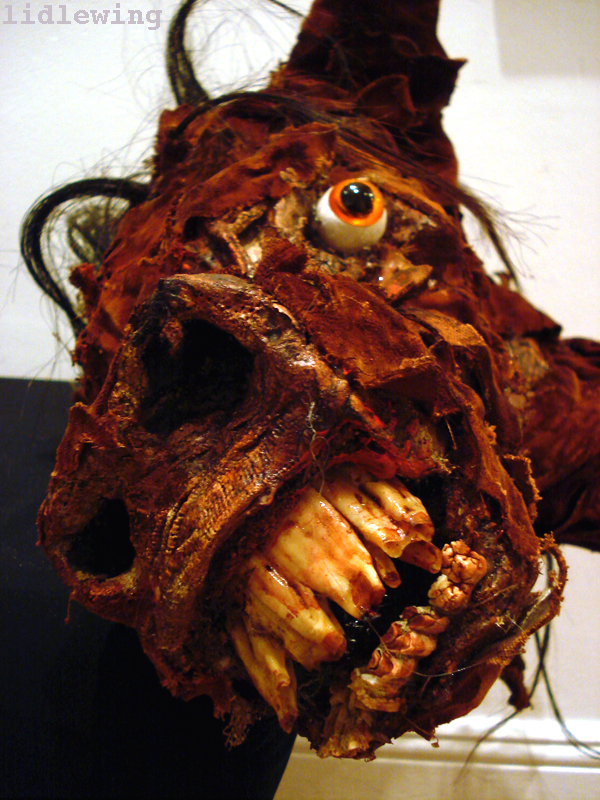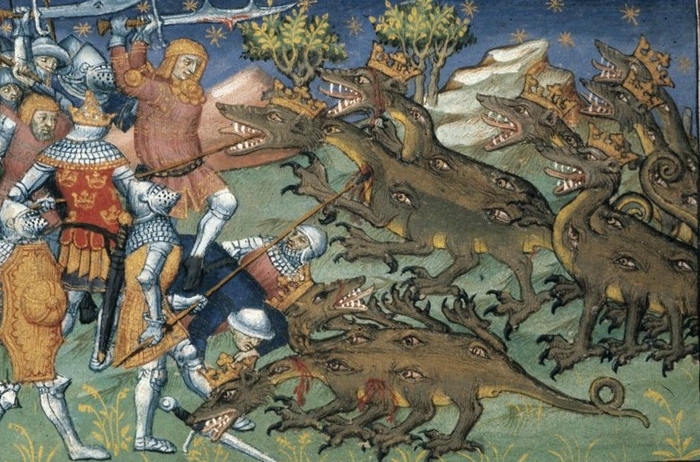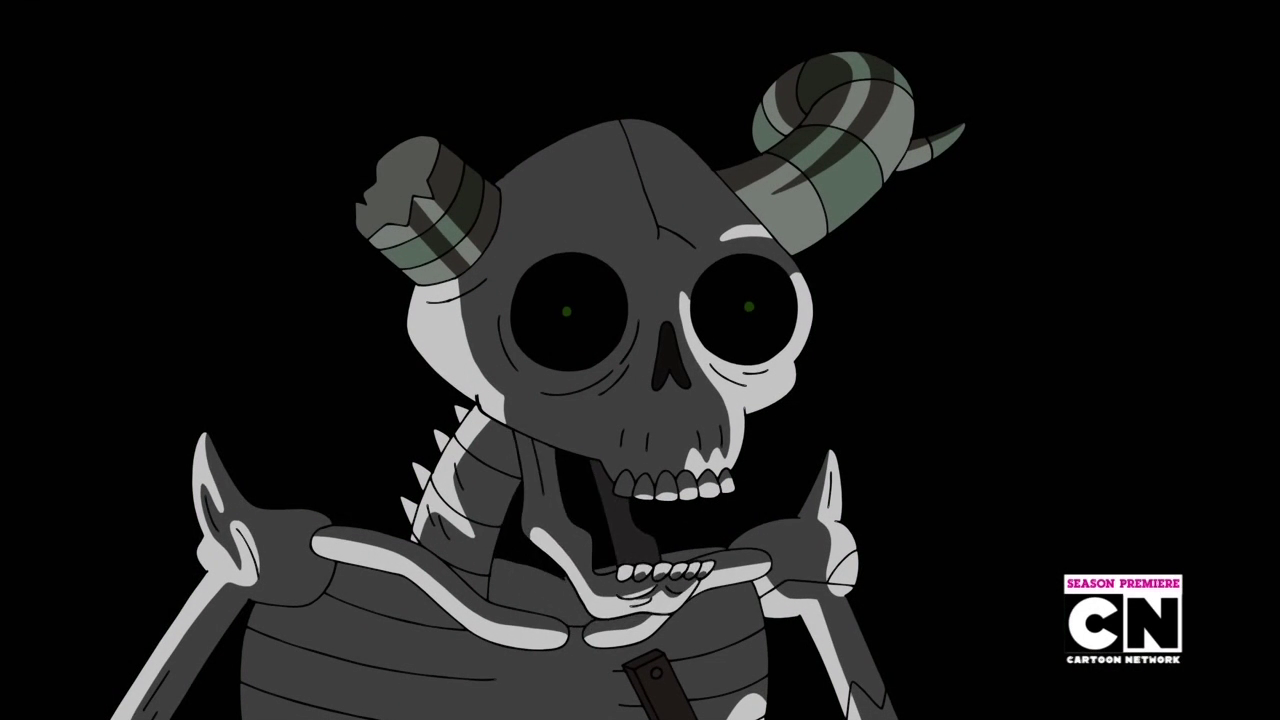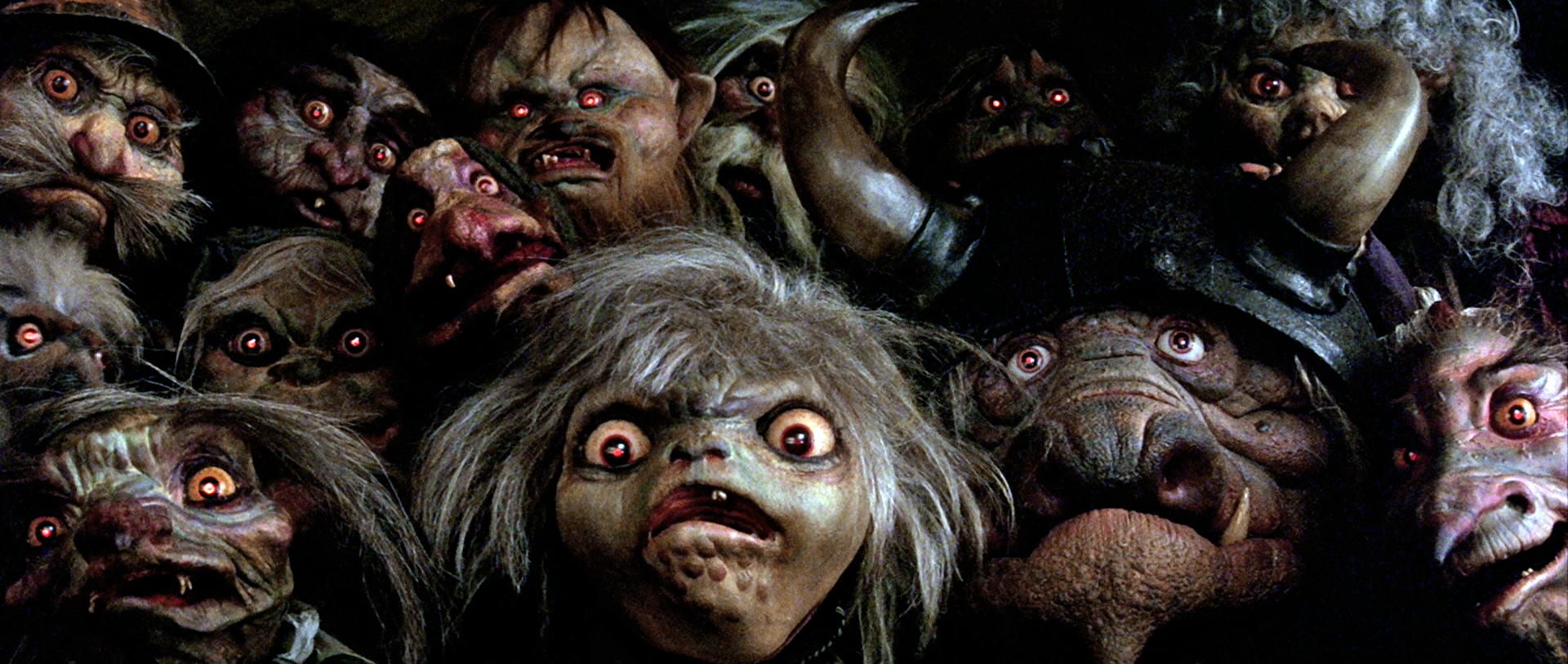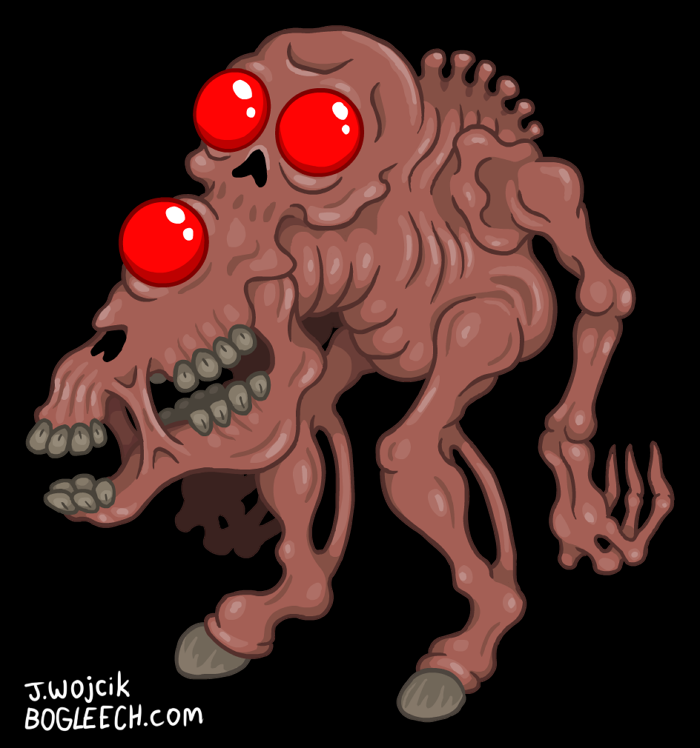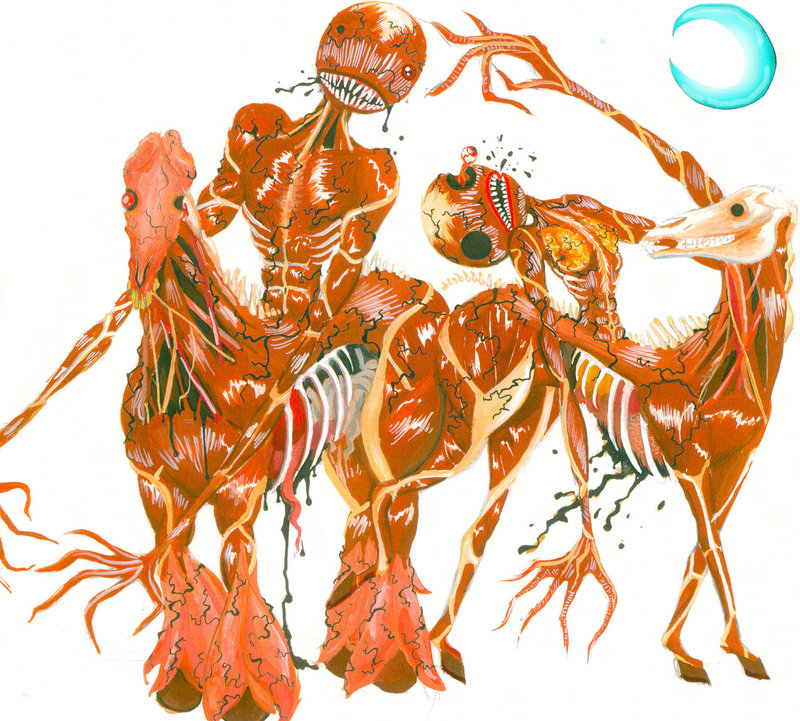Summon Elemental Spirit
Level 1 Magic-User spell
The sorcerer can call forth the basal elemental spirit of some aspect of reality, the pure manifestation of a material or concept. This spell is technically many spells in one, for the higher the level of the elemental which is wished to be summoned the higher the level of the spell. For every elemental spirit, the magician must have access to at least 1 significant item slot's worth of the corresponding material or, if the "material" is immaterial, it must be present at the time of casting. All elemental spirits have similar stats, increasing with the level of the spirit.
Elemental Spirit
Hit Dice: equal to level (with some exceptions)
Armor: varies
Attack: 1, bonus equal to level, 1d6-1d12 damage
Saves: 9+level for all save categories, might vary
Morale: 12
Alignment: Neutral
Coagulate
Material: Blood
Level: 2
The Coagulate is a spirit of blood, in the form of a serpentine tower of thick red fluid. It is crawling with small worms that bulge through the skin, and on its tip the Coagulate has a leech-like mouth. Coagulates have a POISON save of 15, and a DODGE save of 13, but all other save types are as normal. Its attack is a bite attack which deals 1d6 damage, with a chance of it transferring its vein worms into the body of its victim on a failed POISON save. Coagulates can heal themselves by dealing damage to organic enemies with blood (so not robots, undead, plants, golems, or other spirits).
Angel of Dust
Material: Dust
Level: 8
Angels of Dust are spindly things made entirely of the dander and particles which accumulate in uncleaned places. Their eyes are paper cut-outs, jarring on their otherwise featureless and bumpy faces. The wings of the Angels are wide and thin, drab and almost entirely translucent. Whenever the Angel of Dust touches a creature, its very body slowly ages and dissipates, turning to dust itself, its skin flaking off and clothing falling to pieces. The creature may make a MAGIC save to resist the effect and simply lose a limb and whatever gear was held in it or worn on it, but if they fail they die slowly from being turned to dust. The Angel of Dust, though a level 8 elemental spirit, only has 1 hit die.
Pain
Material: Pain
Level: 9
A pure manifestation of pain which can only be summoned forth instantaneously when the pain is experienced. It is a ball of spikes, a mix of larger thorns and more miniscule needles, all growing on a red sphere. The very presence of Pain causes anguish and suffering in those around it, making all in its immediate vicinity roll all rolls twice, taking the worse result, due to the intense pain. Touching the Pain deals 2d10 damage, with only a PARALYSIS save possible to avoid also being paralyzed from pain and unable to move.
Hellbender
Material: Lava or Magma
Level: 3
The Hellbender is a giant magma salamander, an amphibian of immense proportions found in volcanoes and lava streams. They are most notable for their tiny volcano eyes, able to launch burning hot balls of melted stone like a cannon. Hellbenders can attack twice in a round, either 2 bite attacks, 2 launches of the volcano cannon, or some combination thereof. Their bites deal 1d8 damage, and their lava attack deals 1d10 damage each. The POISON, PARALYSIS, and DEVICE saves of the Hellbender are all 15, while the DODGE save is only 9.
Crown of Crowns
Material: Gold and Jewels
Level: 4
The Crown of Crowns is a being made of coins and jewels and ancient heirlooms, an elemental of treasure, with an impressive crown of glittering silver atop its head. The Crown of Crowns wears a purple robe made from a tapestry, and has three arms of gold, each armed with a weapon. This golden elemental can attack three times in a round, dealing 1d6 damage with each attack. It takes half damage from all physical attacks, and has +2 to all saves. However, elemental attacks of all kinds, whether fire or ice or poison or rust, deal double damage to them. They have Armor 2. Every hit point of the Crown of Crowns is equal to one gold piece (or silver piece if using a silver standard), but for every hit point the sorcerer removes from the Crown for the purposes of spending, they get a -1 to their next spellcasting roll.
Showing posts with label Monsters. Show all posts
Showing posts with label Monsters. Show all posts
Friday, June 23, 2017
Friday, November 25, 2016
Mysterious Creatures
Below are old school stats for a number of cryptids, aliens, beings, and spirits from real world cryptozoology, ufology, and conspiracy theories for if you just really want the flatwoods monster in your game.
A note on statblocks: while this is compatible with whatever osr system you wish to use, they are formatted a bit differently from some systems, and there are some stats that assume houserules I use.
Hit Dice: # of d8s rolled for HP. Armor: if present, points subtracted from damage.
Attacks: number of attacks per round, attack bonus, damage of attacks
Saving throws: Toxic save/Paralysis saves/Magic save/Dodge save/Device save
(note: toxic is what is usually called poison, dodge is breath or dragon breath)
(second note: its roll equal to or under for success)
(third note: use dodge save instead of armor class)
Move: movement rate in feet per turn. Morale: number out of 12 for morale checks
Loveland Frog
Hit Dice: 3 Armor: 0
Attacks: 1, +3, d6 damage
Saving Throws: 14/13/15/12/13
Move: 120' Morale: 7
These frogs are humanoid amphibians that hide in sewers and under fetid bridges, congregating in small groups of 2 to 5. Loveland frogs, named after the first town they appeared in, are unspeaking and have unknown motives, crawling and hopping through their stinking homes during the day and only venturing out at night. They all are found carrying sparkling wands that illuminate the area around them with the loud sparkles, and they are able to paralyze creatures with these wands by pointing them at the victim, freezing them in place on a failed paralysis save.
Star Mummy
Hit Dice: 4+1 Armor: 2
Attacks: no attacks
Saving Throws: 16/15/16/13/15
Move: 100' Morale: 10
Star mummies are beings from another world with unusual appearance. They are vaguely humanoid, with grey wrinkled skin and legs fused together into one limb, their gangly arms ending with crab-like claws. Their heads are featureless except for thin slit mouths and their noses and ears nothing but pointed peaks. They float 2 feet above the ground, and travel about in great silvery craft. Star mummies steal away their victims into their spacecraft, but they do not incapacitate them to do so. Rather, if they "stare" at any sort of being, and said being fails a magic save, then they are almost "charmed" by the being and will accompany them into their starship.
Flatwoods Monster
Hit Dice: 6 Armor: 2
Attacks: 1, -1, 1d4 damage
Saving Throws: 17/16/16/14/14
Move: 90' Morale: 12
An almost spectre-like being from another world, its bulb-like head and metallic skirt immediate identifiers. While it can attack with its sharp claws, its main mode of offence is the stinking pestilential cloud that it can produce from under its body, and the disease which it can inflict. It takes a round of combat to release this cloud, and those within it take 1 point of damage per round from the sting to their eyes and to their lungs. In addition, those who enter the cloud must make a toxic save or contract the "Flatwoods Fever". Those who contract it are confined to their bed, oozing black goo from their orifices for several days if not weeks.
Batsquatch
Hit Dice: 3+2 Armor: 0
Attacks: 2, +4, d6 damage
Saving Throws: 14/15/8/14/8
Move: 130' (flying), 110' (walking) Morale: 6
Batsquatches are large apes native to cold northern rainforests and to mountains near them. They are bulky and muscular, and in addition to being large humanoid apes, they have leathery bat wings. Both the hands and feet of a batsquatch are opposable, often grabbing at things with their feet while they fly through the air.
A note on statblocks: while this is compatible with whatever osr system you wish to use, they are formatted a bit differently from some systems, and there are some stats that assume houserules I use.
Hit Dice: # of d8s rolled for HP. Armor: if present, points subtracted from damage.
Attacks: number of attacks per round, attack bonus, damage of attacks
Saving throws: Toxic save/Paralysis saves/Magic save/Dodge save/Device save
(note: toxic is what is usually called poison, dodge is breath or dragon breath)
(second note: its roll equal to or under for success)
(third note: use dodge save instead of armor class)
Move: movement rate in feet per turn. Morale: number out of 12 for morale checks
Loveland Frog
Hit Dice: 3 Armor: 0
Attacks: 1, +3, d6 damage
Saving Throws: 14/13/15/12/13
Move: 120' Morale: 7
These frogs are humanoid amphibians that hide in sewers and under fetid bridges, congregating in small groups of 2 to 5. Loveland frogs, named after the first town they appeared in, are unspeaking and have unknown motives, crawling and hopping through their stinking homes during the day and only venturing out at night. They all are found carrying sparkling wands that illuminate the area around them with the loud sparkles, and they are able to paralyze creatures with these wands by pointing them at the victim, freezing them in place on a failed paralysis save.
Star Mummy
Hit Dice: 4+1 Armor: 2
Attacks: no attacks
Saving Throws: 16/15/16/13/15
Move: 100' Morale: 10
Star mummies are beings from another world with unusual appearance. They are vaguely humanoid, with grey wrinkled skin and legs fused together into one limb, their gangly arms ending with crab-like claws. Their heads are featureless except for thin slit mouths and their noses and ears nothing but pointed peaks. They float 2 feet above the ground, and travel about in great silvery craft. Star mummies steal away their victims into their spacecraft, but they do not incapacitate them to do so. Rather, if they "stare" at any sort of being, and said being fails a magic save, then they are almost "charmed" by the being and will accompany them into their starship.
Flatwoods Monster
Hit Dice: 6 Armor: 2
Attacks: 1, -1, 1d4 damage
Saving Throws: 17/16/16/14/14
Move: 90' Morale: 12
An almost spectre-like being from another world, its bulb-like head and metallic skirt immediate identifiers. While it can attack with its sharp claws, its main mode of offence is the stinking pestilential cloud that it can produce from under its body, and the disease which it can inflict. It takes a round of combat to release this cloud, and those within it take 1 point of damage per round from the sting to their eyes and to their lungs. In addition, those who enter the cloud must make a toxic save or contract the "Flatwoods Fever". Those who contract it are confined to their bed, oozing black goo from their orifices for several days if not weeks.
Batsquatch
Hit Dice: 3+2 Armor: 0
Attacks: 2, +4, d6 damage
Saving Throws: 14/15/8/14/8
Move: 130' (flying), 110' (walking) Morale: 6
Batsquatches are large apes native to cold northern rainforests and to mountains near them. They are bulky and muscular, and in addition to being large humanoid apes, they have leathery bat wings. Both the hands and feet of a batsquatch are opposable, often grabbing at things with their feet while they fly through the air.
Tuesday, January 12, 2016
the NEW GOBLIN, the ORC, and the BUGBEAR
before, i have stated that goblins are a monstrous subculture of all manner of strange beings. such a subculture exists, and they are often compared to the weird race of goblinkind, but they are more akin to all kinds of monsters and spirits that hide away in the societies of the world. goblins themselves are something different entirely. (with the Iconic DnD Races i am trying to make them more akin to weird spirits or beings which can be found in all kinds of environments. this is quite evident in my descriptions of the dwarfs, elves, feral children (hobbits), etc. and will continue to be the theme between such Iconic humanoid species)
GOBLINS
goblins are small humanoid things. they are feeble and weak physically, filled with all manner of disease and poison which they could inflict on others. their skin is green and pocked with sores, their faces are ugly and monstrous, either something bestial, some caricature of old age, or something weirder. they are numerous and everywhere.
goblins evolve through consumption. if they kill and eat some living thing, they will begin to take on traits from it. these traits can be passed on down through the generations of goblinhood, creating many different creatures and strains of goblinkind. what some call Hobgoblins are goblins which ate a lot people. Goblin-Hounds are goblins which ate a lot of dogs. Kobalds are goblins which ate rocks or snatched the small mining spirits into their mouths. there are shiny gold goblins, rusty and impervious iron goblins, long-tailed monkey goblins, and goblin changelings (what do you think they ate to become that). to stay as a goblin, the goblin must eat undifferentiated garbage.
the goal of a goblin is to become some kind of Ultimate Being, all through the consumption of all that they possibly can shove into their mouth. goblins do not eat out of hunger, for they are never truly hungry. goblins only eat to reach their goal of evolution.
sometimes, a goblin will eat so much of a particular thing that they will become identical to that thing, with distinction between being nigh impossible. these people merge into the society, mimicking the culture and the people as well as they possibly can, but still working for the goblin folk, bringing them captive people so that they may become one themselves.
the nature of the goblins that are called Thouls is strange and shrouded by lies and semi-truth. they seem to be either the closest thing to a Perfect Being that the goblins have become, or they are goblin efforts to turn non-goblins into a goblin creature, twisting their bodies into weird forms with surgery, augmenting their biology with weird magic and science.
ORCS and OGRES
orcs are lithe and violent humanoids, with blue or green or red skin. they are obsessed with violence, for they see life as a literal game, with death and destruction as the most fun parts! if you die, you're gonna be reborn really quickly anyways, so it doesn't really matter.
as orcs age, they get taller and taller. the oldest orcs are immense things that are called ogres. some of the most ancient of the orc things are as tall as mountains, with strange knowledge gathered from their millennia of existence. orcs follow anybody who is larger than they are, with no exceptions. orcish leaders are typically called The Tallest, or Big'uns.
there are many different tribes, enclaves, gangs, and armies of orcs. they fight and feud constantly, all for the sole reason that one tribe claims their leader is The Tallest and the other claims that their's is the Tallest. their solution to this is battle, and whoever wins obviously was bigger and badder
there is a stereotype that ogres are dumb brutes, nothing more than huge slabs of muscle and fat. this is most definitely not the case, as the tallest orcs (ogres) tend to be even more experienced than other orcs, making them more knowledgeable. the smaller orcs are the ones that are really not much more than savage brutes, in it for nothing more than fun.
BUGBEARS
bugbears are strange things. they are shape-changing creatures which hide in closets, under beds, outside windows, and in the darkened recesses of attics and basements. they take on fear-inducing forms, but for what reason people can only guess at. some say they eat fear, others say that they just do it for fun. they mutter and they make the floorboards creak. they are the things that move all of the stuff in your room while you are asleep. they are the things which gaze at you through the window, but which you claim to only be the boughs of some dying tree. they are the things that snatch away children in the night, and the things that crawl through hallways and through the walls, moaning and groaning.
what bugbears look like in their true forms is unknown. they change into any number of faces and of bodies and of skins. some may look like furry things with the head of a jack-o-lantern, others will look like meaty cows and horses but with something off. there are those with skin of cracked porcelain, and those who look like huge hulking hairy brutes. bat wings, fish fins, finger bones, yellow eyes, scaly skin, dirty fur, and suckered tentacles.
for some reason, the feeding habits of the bugbears are what most speak of them. some say that they are child-eaters, while others go broader and claim that they eat of the flesh of humankind. the above suggestion that they feed on fear is another common one, as is the idea that they do not eat at all, and instead are removed from the ecosystem entirely.
bugbears, though not a kind of creature that interacts with people very often beyond instilling fear and terror, are oftentimes found in the monstrous subcultures of hidden things that dwell in many settlements. however, since bugbears have unnatural shape-changing power, they are essentially indistinguishable from the many other monsters, goblins, faeries, undead, vampires, and mutants which belong to such cultures and frequent businesses that cater to the monstrous palette.
(i try to make all of the intelligent species that i create have a specific goal or motivation. dwarfs want to make stuff, elves want to tear the universe limb from limb, feral children want to do childish things and never age, goblins want to become a Perfect Being, orcs just want to have fun (and get taller while doing it), bugbears want to cause fear, k'kladorf want to isolate themselves, cadavers (might) want to find out who they were in life, werewolves and vampires want to reproduce, orcas want to steal and pillage, etc.)
GOBLINS
goblins are small humanoid things. they are feeble and weak physically, filled with all manner of disease and poison which they could inflict on others. their skin is green and pocked with sores, their faces are ugly and monstrous, either something bestial, some caricature of old age, or something weirder. they are numerous and everywhere.
goblins evolve through consumption. if they kill and eat some living thing, they will begin to take on traits from it. these traits can be passed on down through the generations of goblinhood, creating many different creatures and strains of goblinkind. what some call Hobgoblins are goblins which ate a lot people. Goblin-Hounds are goblins which ate a lot of dogs. Kobalds are goblins which ate rocks or snatched the small mining spirits into their mouths. there are shiny gold goblins, rusty and impervious iron goblins, long-tailed monkey goblins, and goblin changelings (what do you think they ate to become that). to stay as a goblin, the goblin must eat undifferentiated garbage.
the goal of a goblin is to become some kind of Ultimate Being, all through the consumption of all that they possibly can shove into their mouth. goblins do not eat out of hunger, for they are never truly hungry. goblins only eat to reach their goal of evolution.
sometimes, a goblin will eat so much of a particular thing that they will become identical to that thing, with distinction between being nigh impossible. these people merge into the society, mimicking the culture and the people as well as they possibly can, but still working for the goblin folk, bringing them captive people so that they may become one themselves.
the nature of the goblins that are called Thouls is strange and shrouded by lies and semi-truth. they seem to be either the closest thing to a Perfect Being that the goblins have become, or they are goblin efforts to turn non-goblins into a goblin creature, twisting their bodies into weird forms with surgery, augmenting their biology with weird magic and science.
ORCS and OGRES
orcs are lithe and violent humanoids, with blue or green or red skin. they are obsessed with violence, for they see life as a literal game, with death and destruction as the most fun parts! if you die, you're gonna be reborn really quickly anyways, so it doesn't really matter.
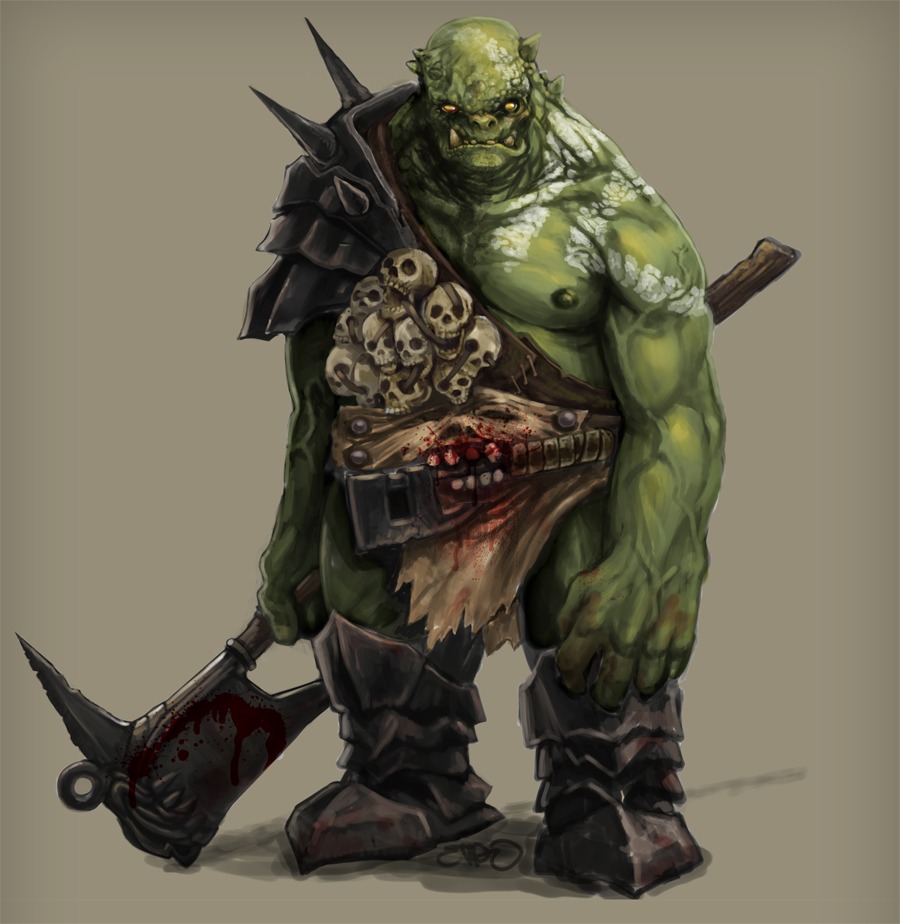 |
| orcs are like this but always super happy while slicing your head off with that ax |
as orcs age, they get taller and taller. the oldest orcs are immense things that are called ogres. some of the most ancient of the orc things are as tall as mountains, with strange knowledge gathered from their millennia of existence. orcs follow anybody who is larger than they are, with no exceptions. orcish leaders are typically called The Tallest, or Big'uns.
there are many different tribes, enclaves, gangs, and armies of orcs. they fight and feud constantly, all for the sole reason that one tribe claims their leader is The Tallest and the other claims that their's is the Tallest. their solution to this is battle, and whoever wins obviously was bigger and badder
there is a stereotype that ogres are dumb brutes, nothing more than huge slabs of muscle and fat. this is most definitely not the case, as the tallest orcs (ogres) tend to be even more experienced than other orcs, making them more knowledgeable. the smaller orcs are the ones that are really not much more than savage brutes, in it for nothing more than fun.
BUGBEARS
bugbears are strange things. they are shape-changing creatures which hide in closets, under beds, outside windows, and in the darkened recesses of attics and basements. they take on fear-inducing forms, but for what reason people can only guess at. some say they eat fear, others say that they just do it for fun. they mutter and they make the floorboards creak. they are the things that move all of the stuff in your room while you are asleep. they are the things which gaze at you through the window, but which you claim to only be the boughs of some dying tree. they are the things that snatch away children in the night, and the things that crawl through hallways and through the walls, moaning and groaning.
what bugbears look like in their true forms is unknown. they change into any number of faces and of bodies and of skins. some may look like furry things with the head of a jack-o-lantern, others will look like meaty cows and horses but with something off. there are those with skin of cracked porcelain, and those who look like huge hulking hairy brutes. bat wings, fish fins, finger bones, yellow eyes, scaly skin, dirty fur, and suckered tentacles.
for some reason, the feeding habits of the bugbears are what most speak of them. some say that they are child-eaters, while others go broader and claim that they eat of the flesh of humankind. the above suggestion that they feed on fear is another common one, as is the idea that they do not eat at all, and instead are removed from the ecosystem entirely.
bugbears, though not a kind of creature that interacts with people very often beyond instilling fear and terror, are oftentimes found in the monstrous subcultures of hidden things that dwell in many settlements. however, since bugbears have unnatural shape-changing power, they are essentially indistinguishable from the many other monsters, goblins, faeries, undead, vampires, and mutants which belong to such cultures and frequent businesses that cater to the monstrous palette.
(i try to make all of the intelligent species that i create have a specific goal or motivation. dwarfs want to make stuff, elves want to tear the universe limb from limb, feral children want to do childish things and never age, goblins want to become a Perfect Being, orcs just want to have fun (and get taller while doing it), bugbears want to cause fear, k'kladorf want to isolate themselves, cadavers (might) want to find out who they were in life, werewolves and vampires want to reproduce, orcas want to steal and pillage, etc.)
Thursday, July 9, 2015
Babel, The Tower Of Spirits
In the seas toward the equator of the world, there juts forth a great tower. It is the only above-water sign of an ancient civilization that lived here once, before their resplendent metropolis was sucked beneath the waves. This structure was their greatest achievement, for it grew so high so as to break into the heavens themselves. When the rest of their magnificent empire fell beneath the ocean, this great tower still stood, and still stands today, as a testament to the powers and knowledge of that great nation, for no others have been able to construct such a tower.
The peoples of the islands that surround this tower want some of that knowledge and power. They will pay nearly anything to have folks who hold their lives in less regard delve into the unknown depths of this tower and retrieve the ancient artifacts and knowledge of the long-dead empire.
And you really must have almost no regard for your life and for your safety to enter the tower. In the centuries and millennia since it fell, it has become overrun with monsters and creatures of all sorts. The upper levels, those that force themselves into the void of heaven, are filled with all sorts of alien creatures, such as angels. The lower levels, those that are beneath the waves, have become overrun with sea devils and other oceanic monsters. These creatures, along with those constructs and beasts left over by the ancient civilization, mutated or eroded by the forces brought into the structure, guard the secrets of the ancient peoples.
Essentially, this is a megadungeon concept that becomes more dangerous the higher up and the lower down you go, rather than just in one direction. Some specific factions, items, and monsters that might be found in Babel, The Tower Of Spirits are detailed below.
Normal DnD Creatures in Babel
The rats here are like fish. Or they are like light. Mundane creatures look more normal the closer to the center of the tower they are, but the lower down or the higher up you go, you will find that they have changed to suit the environment. In the lowest levels, the rats look like quadrupedal fish with unblinking eyes and toothy maws. In the highest levels, the rats look like balls of light with four spindly legs. Mostly, you will just use the same statistics, but switch out appearances.
The zombies that are low down are bloated with water and the skeletons are covered with kelp and sea stars. Vampires have eyes of black and mouths like lampreys and can become goblin sharks or clouds of hagfish slime. In the upper levels, zombies are the corpses of those who have died, possessed by space ghosts or alien energies. They do not decay because of the alien effect on their flesh. Those upper levels have additional shadows even in places where light shines. Vampires of these upper levels are featureless and smooth, until they open their mouth and you see a hole ringed with teeth of glass.
Cephalopoid mind flayers hide in the darker corners of the lower levels, and eye-covered beholders float through the halls of the upper levels.
Not Normal DnD Creatures in Babel
Angels live in the higher levels. They are made of rings of gold and balls of fire. They are covered in circles of eyes and limbs of animals. They speak only in the language that the stars throw at each other in the voids between them. These are spirits of order whose goals are harmful to meaty creatures such as humans, for flesh is chaotic and disorderly. They can take forms of meat, but only do so begrudgingly, and they remove creatures from their prisons of meat to bring them in contact with the greater order of the universe. They fall into orders, levels, and circles, and each celestial being has a role and a place. (angels will be described more in-depth in another post)
Saratan, the great crab, controls one of the lower levels. They are the size of an island, and on their back there lives a culture of piscine peoples.
Alien fungi and extraterrestrial flora grow on the higher levels. Those who breathe in the spores and the pollen contract unknown diseases and alien allergies, and some might become the mold-controlled puppets called Spore Cosmonauts.
Some fish and other ocean animals have adapted themselves for the slightly less wet corridors and rooms of the lower levels. These are angler fish that crawl around on the ceilings and floors of the tower and octopi that bound along, hunting anything they near.
Factions of The Islands
A cult that worships the fish gods Father Dagon and Mother Hydra want artifacts and creatures from the lower levels. Some even say that their gods dwell in the deepest parts of the tower, and they will pay ludicrously to bring some of them to these piscine deities.
A church of Bog wishes for more information about the kingdoms of heaven and about the nature of Bog. If you retrieve information about either of those things from a bonafide angel, they will pay you handsomely. They would also totally be down to get some holy relics to treasure or unholy false idols to destroy.
A slave ship has arrived recently. The people here consider slavery horrible, for it infringes upon the freedoms of the people, but they don't consider the fish folk people, so they're completely fine if you kidnap some fish people from the tower and sell them to the slavers. The slavers will pay additional money for aquatics, as they can work in underwater environments.
There is a wizard that requires the ichors and the parts of angels for spells that they are working on. They will reward with not just silver, but also with the spells and magical items themselves, if you promise not to share them too much.
The tribe on a small island near the tower considers it to be the home of their god. They hate their god. If you can bring back the head of their god, they will reward you with fame and honor, as well as a high standing in the tribe.
Friday, July 3, 2015
Four Undead
The Zombi and The Skeleton
The zombi and the skeleton are two creatures most commonly created by necromancers. They are both created using the same sort of vile magick, with the only difference being the level of decomposition present in the walking cadaver. Zombis can even be made from living people, though once they are under the necromancer's control, there is almost no way to get them back.
The consciousness of a zombi or of a skeleton is under the control of the necromancer, and thus, these creatures have no amount of self preservation. If they catch on fire, they will keep on kicking until the last piece of ash is blown away in the wind. If all that is left of a zombi is a pile of viscera, the bloody pulp will ooze along, still going at its task. Even if the brain of the zombi is removed from its body, the necromancer will retain control of both parts, and you have just made a slow cerebral ooze and a stumbling walking corpse. The only way to defeat a zombi or a skeleton is to completely destroy every single part of it. Just getting it down to 0 HP isn't going to cut it.
Even though the necromancer has control over the body of the undead creature, occasionally the real consciousness of the body will break through. You might hear it scream for help or suddenly run away from you before walking back at you. If the necromancer dies, the zombis and skeletons that now control their own bodies will try to enact vengeance on the bokor, and might burn the body, eat it, or simply tear it limb from limb. However, they are still definitely affected by their time under the control of the wizard, and so they have to resist every urge to devolve into a mindless walking corpse.
The Ghoul and The Ghast
Ghouls are created by a terrible plague that makes you into a horrible cannibalistic monster (called the Cannibal's Illness). It slowly makes you into an almost human monster that only wishes to gorge itself on meat. Your eyes glaze over and you forget about who you once were. You become an immortal abomination filled with disease and decay, and every injury just causes you to become more monstrous and mutated.
Something cuts off your arm, and you regrow an arm that is almost a good arm, but not quite. Meanwhile, your arm that was once connected to your body grows into a smaller ghoul that just has a huge arm. Both of these monsters are you. If you are cut in half, each side regrows the other side, but it might be covered in tumors or eyes or teeth. Your heart is ripped from your body, and it just grows spindly legs from your veins, and crawls on the ground, spitting ghoul blood on everything. A new ghoul might look like someone who just needs a shower or a bandage or two. An old ghoul is covered in tumors and veins, with two blind heads and a mouth filled with almost shark-like teeth.
 |
| By Jonathan Wojcik of Bogleech, for his upcoming game Mortasheen! |
Ghouls might remember a thing or two of their life as a human. They might remember taxes, or the king, or they might remember children. They might even remember how to make them! If a ghoul tries to reproduce with another decaying abomination, it will probably work. It won't produce a normal baby, and it won't produce a really small ghoul. No, reproduction between these undead monsters creates the strange creatures known as ghasts. These monsters might look like a deformed baby, or they might look like a huge embryonic dragon-like beast. Crawling mountains of conjoined fetuses, hive-like infants filled with parasitic flies, anencephalic gremlins, and even more diversity of these undead descendants are produced when two or more ghouls try to make a child.
:origin()/pre04/ee70/th/pre/f/2007/126/7/7/mortasheen___spawnlet_by_scythemantis.jpg) |
| Also by Jonathan Wojcik for Mortasheen |
If you have contracted the Cannibal's Illness and are not yet a ghoul, you are what is called a half-ghoul. You will forget you family and friends and your life before you started becoming an undead monstrosity. You will be overcome with the urge to eat constantly, and only ever eat meat. Plants and other foods will turn to sand, mud, or dirt on your tongue. Slowly, you will lose all thought beyond eat, and eventually you will become a ghoul.
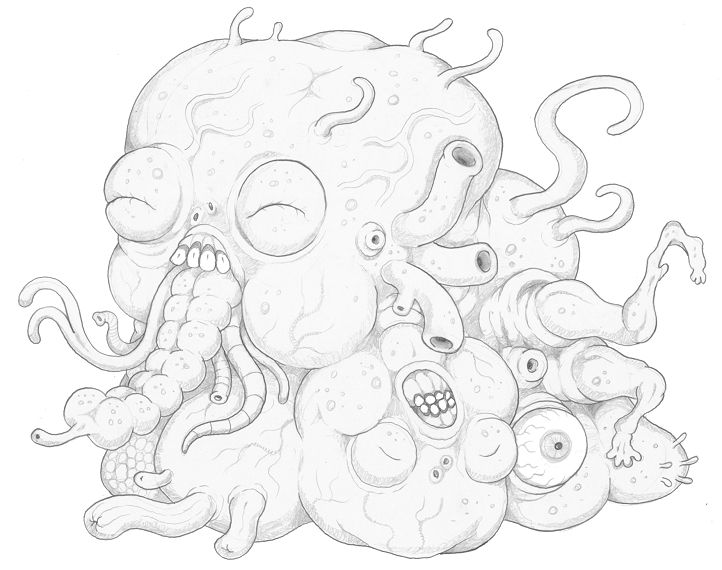 |
| Also for Mortasheen |
Thursday, June 25, 2015
Towards More Interesting Bandits
Bandits
Bandit tribes and gangs should have evocative names and interesting subcultures and whatnot. Essentially, I'm just gonna share some bandit tribes that I came up with earlier today for a hexcrawl I'm working on, as well as some new ones. The base stats for the Bandit are:
HD: 1
AC: 14
Attacks: 1 (weapon)
Damage: Varies by weapon (typical weapon is listed with bandit tribe description)
Movement: 120'
Intellect: 9-12
Morale: 7
If bandits are found traveling, then you will encounter 2d6 of them. If they are found at their own camp, you will encounter 3d10 of them. Other special features are based on their tribe/gang.
Some Bandit Tribes
The Bloodies: They drench themselves with blood before fighting. If fighting without blood on their body, they have -2 to all of their rolls. They typically arm themselves with swords (1d6+2).
The Eye-Gougers: They gouge their eyes out with knives. Some wear eyepatches or blindfolds. They have -4 to hit with attacks, but attacks deal double damage (1d4 becomes 2d4). They arm themselves with knives (1d4)
The Biters: They crawl on fours, completely naked, and attack by biting, rather than using weapons. They have +4 to hit with their bite attack (1d6), and have +1 to hit with all other attacks. Some might think they are druids.
The Garbage Men: They cover themselves with trash and other rotting things. Creatures around them must succeed a save vs. paralysis or fall unconscious because of the stench for 1d4 rounds. They typically carry clubs (1d6+1)
The Crack Heads: They break open their skulls and let the brains within be free for at least a few moments. Every round, they must make a Con check (con is 2d6+6) or fall unconscious for 1d6 rounds. They can cast spells as a level 1d6+1 MU. They are armed with clubs (1d6+1)
The Chains: They wrap rusty chains around their body that can snatch people from wear they stand. When they make an attack, they can choose to forego the attack and instead wrap the target up in the chains. The target must make an opposed Strength check every round to escape (bandit strength is 4d6, drop the lowest). They typically carry knives (1d4)
The Drunkards: They fill themselves with booze before fighting. When drunk, they have -1 to their AC and attack rolls, but +5 to all of their saving throws. They carry broken bottles (1d4+2).
The Ghouls: They are emaciated, almost undead-looking. During combat, they can eat a corpse to gain the attack bonus, AC, and saving throws of the dead person for the next hour. They attack with their claws (1d6+1)
The Gemini: They are tied together with ropes and tubes that share their blood. All of their statistics are doubled (except for AC and speed) (thus, they have 2 HD, 2 attacks per round, etc.). Some of them are actually connected by flesh.
The Highwaymen: They wear elaborate costumes and strange guises. In addition to their normal stats, they have the abilities of a level 2d4 thief. They can backstab and use burglary skills.
The Turtles: They have thick shells or carapaces strapped to their backs. As an action, they can retract into these shells. The shell has AC 18, but their body is still AC 14. The shell has 2d6 HP.
The Stilt Storks: They strap their legs on thin, yet strong, stilts so that they can be above the people they are fighting. The legs must be broken before you can attack the bandits in melee. They have AC 16 and 3d6 HP.
Bandit tribes and gangs should have evocative names and interesting subcultures and whatnot. Essentially, I'm just gonna share some bandit tribes that I came up with earlier today for a hexcrawl I'm working on, as well as some new ones. The base stats for the Bandit are:
HD: 1
AC: 14
Attacks: 1 (weapon)
Damage: Varies by weapon (typical weapon is listed with bandit tribe description)
Movement: 120'
Intellect: 9-12
Morale: 7
If bandits are found traveling, then you will encounter 2d6 of them. If they are found at their own camp, you will encounter 3d10 of them. Other special features are based on their tribe/gang.
Some Bandit Tribes
The Bloodies: They drench themselves with blood before fighting. If fighting without blood on their body, they have -2 to all of their rolls. They typically arm themselves with swords (1d6+2).
The Eye-Gougers: They gouge their eyes out with knives. Some wear eyepatches or blindfolds. They have -4 to hit with attacks, but attacks deal double damage (1d4 becomes 2d4). They arm themselves with knives (1d4)
The Biters: They crawl on fours, completely naked, and attack by biting, rather than using weapons. They have +4 to hit with their bite attack (1d6), and have +1 to hit with all other attacks. Some might think they are druids.
The Garbage Men: They cover themselves with trash and other rotting things. Creatures around them must succeed a save vs. paralysis or fall unconscious because of the stench for 1d4 rounds. They typically carry clubs (1d6+1)
The Crack Heads: They break open their skulls and let the brains within be free for at least a few moments. Every round, they must make a Con check (con is 2d6+6) or fall unconscious for 1d6 rounds. They can cast spells as a level 1d6+1 MU. They are armed with clubs (1d6+1)
The Chains: They wrap rusty chains around their body that can snatch people from wear they stand. When they make an attack, they can choose to forego the attack and instead wrap the target up in the chains. The target must make an opposed Strength check every round to escape (bandit strength is 4d6, drop the lowest). They typically carry knives (1d4)
The Drunkards: They fill themselves with booze before fighting. When drunk, they have -1 to their AC and attack rolls, but +5 to all of their saving throws. They carry broken bottles (1d4+2).
The Ghouls: They are emaciated, almost undead-looking. During combat, they can eat a corpse to gain the attack bonus, AC, and saving throws of the dead person for the next hour. They attack with their claws (1d6+1)
The Gemini: They are tied together with ropes and tubes that share their blood. All of their statistics are doubled (except for AC and speed) (thus, they have 2 HD, 2 attacks per round, etc.). Some of them are actually connected by flesh.
The Highwaymen: They wear elaborate costumes and strange guises. In addition to their normal stats, they have the abilities of a level 2d4 thief. They can backstab and use burglary skills.
The Turtles: They have thick shells or carapaces strapped to their backs. As an action, they can retract into these shells. The shell has AC 18, but their body is still AC 14. The shell has 2d6 HP.
The Stilt Storks: They strap their legs on thin, yet strong, stilts so that they can be above the people they are fighting. The legs must be broken before you can attack the bandits in melee. They have AC 16 and 3d6 HP.
Monday, June 22, 2015
Orcs
Orcs are bad news, but they can be talked to. Elves are alien and will murder and burn with reckless abandon, no matter what you say. Orcs can be reasoned with. Orcs have families and children. Even though they do have a culture of violence and don't understand death, they are much more likely to not kill you and your family if you talk to them.
Orcs worship gods that are constantly warring. Their priests drape themselves with bloody spines and crawl through the remains of battles, reading the future through the gore and viscera. All orcs carry weapons, except for the infants, who hunt with their claws and their fangs. Orc currency is skulls and teeth that they take from corpses and their fellow orcs. They make goblins work for them with intimidation, but still treat them better than humans do. They are allies with the hobgoblins, and orchestrate great war campaigns.
Orcs are obsessed with violence, but they see it as more of a game. They think that after they die, they are reborn as another orc, ready to crawl through the gore and claw at anything it sees with its new baby claws. They see death as only an obstacle, and the orc afterlife is either a gauntlet of combat that you must fight through to come back to life (if you were a good orc and murdered as many people and things as you could) or a small village, filled with seemingly friendly people who are actually extremely judging and prejudiced. You must survive in that hell of toxic people with no murder and arson for a few years, and then you come back.
Since orcs are actually extremely innocent and trusting, but love violence and war, they are taken advantage of my more tactically-minded creatures, such as hobgoblins. Even though the Church of Bog has made it so that most people today regard the orcs as some verminous sort of human, many past human societies, as well as non-Boggian cultures throughout the world, graciously accept orcs into their armies and societies. However, special systems have to be made to make sure that these orcs do not kill and burn things that they don't want killed and burned, and so they are usually drafted as low-level cannon fodder in armies, or as gladiators in arenas, where they can be told what things are okay to destroy easily. If an orc child is brought up in another society, they will become like a normal member of that culture, but when an infant they will still hunt for food. There are several cases of elves stealing orc babies and beating them into some unstoppable military force. And by beating, I mean literally beating and abusing them to do their terrible bidding.
Orcs are actually much nicer than the dwarfs and those human cultures touched by the Church of Bog. If you encounter them, they will probably help you if you are in danger, or accompany you through the wilderness. You just have to get used to them catching themselves on fire or storing their swords in their torso and be accompanied by the frenzied, cannibalistic infant orcs.
Orcs never stop growing. Some of the older orcs reach heights of 10 feet or higher, and some rumor that there are 25 foot tall orcs that fight dragons and giants deep in the wilderness.
The Orc (Race)
Class Restrictions Orcs can play every class
Special Abilities Orcs have the following special abilities and features:
- +Strength, -Intelligence (orcs switch their Strength and Intelligence scores, but only if Intelligence is higher than Strength)
- When you reach 0 HP, you can choose to go back up to 1 HP, rather than making the saving throw. You gain an injury from doing this, however. This can only be done once per day.
- Your attack bonus is equal to half your level, rounded up, rather than what is normally indicated for your class (unless you are playing a fighter).
- Orcs save at +3 to paralysis and +4 to poison.
The Orc (Monster)
HD: 1+1
AC: 16
Attacks: 1
Damage: 1d6+2
Movement: 120'
Intellect: 4-7
Morale: 7
The typical orc will have the abilities of a level 2 fighter. 50% of all orcs will be of the typical variety, with 15% being higher level fighting-types, 15% being clerical types, 15% being magic-users, and 5% being of the thief class. They will almost always be found in groups, accompanied by baby orcs, as well as goblins. They will almost never check morale, only if there is extreme danger.
 |
| A very dirty baby orc. Just give it sharp teeth. |
Orc, Baby
HD: 1-1
AC: 14
Attacks: 2 (claw/claw or claw/bite)
Damage: 1d4 claw, 1d6 bite
Movement: 115'
Intellect: 3
Morale: 12
Their claw attack has a +3 bonus to hit, and their bite attack has a +2 bonus to hit. They never, ever check morale, and will only run away if taken by the older orcs. They can climb up walls at the same speed that they can crawl on the ground. These orcs are much more likely to be found alone, but their presence typically heralds a camp of orcs not too far away.
Wednesday, June 17, 2015
Elves
Elves are bad news. They will steal your children, make your crops shrivel, and curse your body. They will crawl into your house at night and murder everyone but you, redecorating with their viscera. It is easy to find an elf because of the trail of disease, discord, gore, and ruin that they leave behind them. Or it will be impossible to find an elf because they hide themselves just outside of your vision. If you meet an elf, you will know. They look human in outline, but they are definitely not human. Their eyes might have slit pupils, or no pupils at all. Their mouth might just have the small cutting teeth of a child, or they might have layers upon layers of needles. They might bleed oil that glows in darkness, or hunts creatures as if it were an ooze. They might have the horns of a goat or the antlers of a stag. They might have the tail of a cow or of a monkey, or scales like a reptile or a fish. They might have cracks in their skin, or skin like porcelain, obsidian, tree bark, or metal. Elves are monsters.
 |
| A family of elves |
Elves are faerie creatures. All fae are horrible, but elves are just some of the most numerous. There are many things that are the bane of elf-kind. Iron and salt destroy their being as well as their flesh, and certain charms have strange effects on them. Elves are confused by faith, just as they are confused by other things of the more mortal world, but they fear clerics. That's because they know that whatever god or spirit the priest is praying to doesn't exist, but they get seemingly limitless, miraculous power from their belief in them and their confidence alone. Clerics are possibly the only thing that elves fear.
Elves might do terrible things, but they aren't evil. They are just alien. They have a complete disregard for more mortal life, and especially human life. They do not care. They only see you as something to be toyed with for their enjoyment.
While everybody knows that elves are dangerous, they don't often know that their animals are dangerous too. If an elf is riding a horse, its probably a unicorn. If an elf is accompanied by a dog, its probably a Coo Sidhe (Coo Shee). The flies around an elf's head are piskies, and the cat is a strange familiar.
The Elf (Class)
The elf is exactly the same as in the normal LotFP rules, but with the following changes:
- The spellcasting change elaborated in this post.
- They take 1.5 times more damage from iron weapons.
- They take 1 point of damage from salt.
- They take 1 point of damage for every point above 10 from iron armor.
- If you choose iron armor/weapons or an animal at character creation, rather than being normal, there are the following changes:
- Iron tools are made from the strange elfmetal (also called mithril)
- Horses are unicorns with hit dice 3+3
- Dogs are Coo Sidhe
- You don't need to eat, but you really like eating, so you drain the food supplies as normal.
- You don't need to sleep (see below)
- You can go into the world of faerie at-will. This (sort of) replaces sleep, as if you stay in the more mortal world, you become less magical and more mortal, losing your magical powers. The more you become mortal, the more difficult it is to go into faerie.
- They cast spells from their own spell list, rather than the MU spell list.
- They are able to see in darkness.
- + Charisma, - Constitution (they switch their Int and Con scores if Con is higher than Int)
The Elf (Monster)
HD: 1+1
AC: 14
Attacks: 1
Damage: 1d8+1
Movement: 120'
Intellect: 16-18
Morale: 10
The average elf will have the abilities of a level 3 elf. If they are accompanied by animals, they will be monstrous (horses will be unicorns, dogs will be Coo Sidhe). There is a 65% chance that they will be of a higher or lower level than third. They will only check morale if the cleric in the party prays for a miracle. They will attack with daggers typically, but they can employ their claws, which deal 1d6+1 damage. Both attacks have +2 to hit, unless they are a higher or lower level.
Unicorns and Dragons
Unicorns
Unicorns are very, very rare. You are exceedingly lucky to have seen even but one in your entire lifetime. Nobody knows for certain why they are so rare, but different people say different things. The clergy of the Church of Bog say that the unicorn was a perfect creature, taken from the world as punishment for our transgressions. People see the unicorn because they are perfect in the eyes of Bog. The scholars and the wizards say that the unicorn was hunted to extinction because its body parts had magical properties, according to the wizards, and because their body parts were thought to have magical properties, according to the scholars. The conspiracy theorists say that they were taken by otherworldly beings, or that they were hidden by the Church of Bog. The dwarfs say that all things of the flesh will die one day, and the unicorns were some of the first to go. The biomancers and vivimancers don't really care why they are so rare, but they really, really want unicorn parts again. The elves know what happened to the unicorns.
The unicorns hid themselves. They are terrible creatures, with mouths filled with needles of bone and eyes wild with hunger. Instead of hooves, they have human-like hands, fingers tipped with hoof-like nails. Their tails are prehensile, and their mouths, horns, and hands are always caked with blood and viscera. They are bloodthirsty and love to hunt and gorge themselves on meat. They are cunning. They are actually much more common than most people know. They crawl through the forests and the cities, stalking peasants, hunters, adventurers, and tradesmen. They are very adept at being hidden, and the reason they are rare is because they rarely slip up. Most only see them when one tries to eat them. The elves know all of this, because they made the unicorns. They crafted these equine predators, and elves will often be accompanied by hornless unicorns. Be wary around elves, as their horses are just as dangerous as they are. It is true that the unicorn's body parts have magical properties. Most think its just the blood and the horn, but its really every part of the creature. Clothing made from unicorn hair is immune to fire. Elves drink the blood and urine of their unicorns to increase their magical or fighting power. Glue made from unicorn hooves never breaks. Have a fun time getting these parts, though. Unicorns are immortal. Unless they are turned into dust and scattered in the wind, they will keep on kicking. Even just a single unicorn leg will eventually grow into another sadistic horse.
HD: 4+4
AC: 17
Attacks: 2 (+3 claw/+3 horn or +3 claw/+1 bite)
Damage: claw: 1d6+3, bite: 1d10+4, horn: 1d8+4
Movement: as horse (I don't know what that is)
Intellect: 16
Morale: 10
Unicorns will commonly (60%) be found in the company of elves. These elves will occasionally cut the unicorn, dealing 1 point of damage, drink the blood, and gain 1 level of class abilities (not hit dice, but attack bonuses and spellcasting). This lasts for 1d10 rounds. Player character elves can do the same, but fighters and magic-users cannot. The unicorn will heal 2 hit points per round, including after they are 'killed', unless they are utterly destroyed (turned into dust, melted, etc.). If pieces of the unicorn are left, they will each become a healthy unicorn. Unicorns can climb walls at the same speed as they can walk. Unicorns speak their own language and the tongue of elves.
Dragons
Dragons are terrible. Everybody knows that. Big dragons crawl down from their mountain lairs and crush villages under their paws and claws, and more common drakes swim through muddy rivers and poison the land. Some dragons have the faces of men or of dogs or of birds, and bodies like a lizard or scorpion. Their wings have eyes, and their skin spews poisonous clouds. Their mangy skin is cold to the touch, and it is still even though you can hear the monster breathing. Everybody hates dragons, but nobody knows what exactly they are. The Church of Bog says they are demons. The wizards laugh at the church's claims about the dragons, stating that the dragons are some magical accident, or maybe some mutant animal. The scholars are confused by the dragons. The elves hate the dragons and try to kill them on sight. Some soldiers say that the dragons are to beasts what the orcs are to humans. Many people agree with them.
By Rattyarts
HD: 2-11
AC: 15-20
Attacks: 3 (+4 claw/+4 claw/+3 bite)
Damage: claw: 1d8+3, bite: 1d12
Movement: as human+10' per hit die
Intellect: 3-10
Morale: 12
Dragons will have 1d4 of the following abilities (roll 1d12 1d4 times):
- Flight (has fly speed equal to walk speed)
- Breath weapon (save vs. breath or take xd6 damage (x=hit dice). Damage type determined by you)
- Poisonous presence (all creatures around it take xd2 damage per round (x=hit dice). succeed save vs. breath and take half damage)
- Many legs (double speed, can climb walls)
- Night vision
- Religious (can use miracles as a cleric of level equal to their hit dice. Worships Drakonik, the spirit of dragons)
- Magical (can cast spells as a magic-user of level equal to their hit dice)
- Thick shell (AC increased by 2 points)
- No legs (half speed, must crawl like a slug)
- Elf vision (can only see elves and related creatures)
- Immune (takes no damage from anything but magic, which it takes half damage from)
- Amnesiac presence (all creatures around it forget things easily. Characters must make an ability check based on their class or lose a level of experience (strength for fighters, dexterity for thieves, intelligence for magic-users, wisdom for clerics)
They will never be found in the presence of other creatures, and the adventurers feel something off when they are approaching it.
Monday, June 15, 2015
Star-Liches and Other Space Creatures
(I'll probably be making a weird fantasy setting for my LotFP stuff, so this'll be the first post 'bout that)
Space is really big and really weird. It is filled with monstrous abominations and aliens, strange stars and strange worlds, and the nothingness around that other stuff. Creatures made of broiling eyes and gases float between soot-black stars, dominated by races of violent metal-men. Skeletal liches fly on their rainbow ziggurats, looking for anything to entertain themselves. The void watches.
Star-Liches
From Adventure Time
HD: 10-20
AC: 19
Attacks: 1
Damage: 1d4+2
Movement: 180'
Intellect: 21+
Morale: 11
Star-liches are those magic-users that have chosen to exile themselves to the vast reaches of space. They are created in a similar manner to the undead wizards of earth, but there are some differences because of the unending void that the lich resides in. Star-liches have the casting ability of a magic-user of a level equal to their hit dice. They are able to force an existential fear in a creature that they wish, making the target make a save vs. existentialism (paralysis). If the target fails such a save, they stop thinking they exist. They cannot move, nor defend themselves. If the target succeeds their saving throw, then they begin to question their own reality, losing 2 points from each of their mental ability scores (INT, WIS, CHA). Star-liches typically carry with them many items of magical natures. Star-liches speak a strange tongue, like the language spells are written in, but mutated and changed.
Space Whales
From Pathfinder
Huge creatures float through the infinite swaths of nothingness that comprise outer space. Some look like creatures from earth, but most look like things much, much stranger. They are called space whales, cosmobeasts, and astral leviathans. They cannot be fought, both because of their size and alien nature, and because they do not wish to fight. They do nothing, suspended in nothing. Sometimes, they fall down to our planet or to others, and interesting things happen when this occurs. Scavengers, both the more mundane and the more unnatural, crawl on the massive cadaver, ripping the gaseous flesh from the magnesium bones, while the alien parasites of the monster hunt them and the people who have arrived to gather esoteric materials from the intergalactic corpse. Sometimes they are still alive, but creatures still take from them. Their metal bones are exposed as their poisonous spirits infect the animals around them.
Spore Cosmonauts
From Fallout: New Vegas
HD: 4-6
AC: 14
Attacks: 3
Damage: 1d6+chance of infection
Movement: 140'
Intellect: 3
Morale: 8
There are fungi that root their mycelia in small planetoids or in the wreckage of spacecraft. They release spores that are blown by solar winds, and eventually meet the flesh of a living being. The fungus grows in the creature, sending fibrous growths throughout the meat of the host. It is extremely painful, but if you are not experienced, you cannot differentiate it from other plagues. It is once mushrooms grow from the host's body that it becomes apparent what the nature of the illness is. After but a few days, the host becomes controlled and covered by the fungus. Although any living creature can fall prey to the fungal growths, those most susceptible are those who adventure in space, or cosmonauts. The air around a spore cosmonaut is thick with infectious spores, and with each attack that the monster makes, the target must make a save vs. infection (poison), or catch the fungal growths themselves. After a few months, all of the meat in the host's body is consumed and the body disintegrates.
Tuesday, March 17, 2015
The Races of The Megadungeon Part 2
I forgot to say this in the last one, but those first three are the only playable races at the very start of the game, and all following races either have to be discovered or are not playable.
From Brian Froud and Jim Henson's movie Labyrinth
Goblins
Goblins are an incredibly populous and varied race commonly treated as a necessary evil by some, and as vermin by others. They are common enough in the nations and empires of humanity, but people, specifically humans, generally mistreat them. Nobody truthfully knows how they came to be, but there are many theories. Some say that they were mortal creatures spawned by a fae creature called the Goblin King from root vegetables such as turnips and carrots, while others, mostly clergy members, just say that they are unnatural abominations, probably descended from demons or something. They spoke of the race of orcs before humanity was introduced to them, and they claim that they were the creators of them. They are related to the race of hobgoblins.
From Brian Froud and Jim Henson's movie Labyrinth
Goblins
Goblins are an incredibly populous and varied race commonly treated as a necessary evil by some, and as vermin by others. They are common enough in the nations and empires of humanity, but people, specifically humans, generally mistreat them. Nobody truthfully knows how they came to be, but there are many theories. Some say that they were mortal creatures spawned by a fae creature called the Goblin King from root vegetables such as turnips and carrots, while others, mostly clergy members, just say that they are unnatural abominations, probably descended from demons or something. They spoke of the race of orcs before humanity was introduced to them, and they claim that they were the creators of them. They are related to the race of hobgoblins.
Hobgoblins
Similarly varied, the stronger, taller, and rarer hobgoblins are generally treated as horrible brutes, and when people accept for jobs at all, they are almost always that of the more violent types, such as mercenary, soldier, or bodyguard. The first hobgoblins came into human-controlled lands from outside, and it is unknown where or why they appeared within humanity's land. They also spoke of the orcs before humanity was introduced to them, but they spoke of them more as equals rather than the way of the goblins, which was more like servants or slaves. When questioned about the creation of the orcs, they attempt to avoid the question, but always agree with the goblins about their origins. Nobody knows the origin of the hobgoblins, just like the race of goblins, and most theories stem from the theories for the goblins: they were grown from pumpkins or trees by the Goblin King, or they are stronger demons.
Orcs
Orcs were not known to the empires and nations of humanity until after they arrived in the New World to explore the Megadungeon. They are just as varied as both the races of goblins and hobgoblins. Although it is universally agreed that the goblins created the orcs, what is not agreed upon is exactly how they were created. Even the goblins never want to talk about it, simply continuing to brag about their creation of them rather than actually speaking of how they were made. People theorize about this too: the Great Church states that orcs were made from humans, possessed by demons in some foul ritual, distorted and mangled from their previously normal form. Some people say they were mutated from farm animals and wildlife with magick, citing some orc's bestial features. Some say that they crafted in cauldrons or pools by goblin witches, servants of the Goblin King, but what they are crafted from varies (some say humans, others say they are made from corpses and the beasts consuming them). The orcs themselves hate to be reminded of their creation, and always try to change the subject.
Monday, March 16, 2015
The Races of The Megadungeon Part 1
Humans
Humans have many nations and empires in the Old World, and their countries were the first to discover the New World and the Megadungeon. They founded the Great Church, and they "discovered" the race of the halflings. According to them, they are the most natural race, and so are the race that all other races are compared to.
Dwarfs
Dwarfs used to control vast swathes of land, both above and below the ground, with their immense empires. In the superstitions of many past human settlements, dwarfs controlled all that was below the ground. However, for some unknown reason, all of the empires of the dwarfs fell, leaving behind great ruins of keeps and castles. Of the dwarfs that existed, most are either dead or insane and delusional. The very few dwarfs that aren't one or the other are adventurers, not because of any grand reason, but because dwarfs really like money, and it is said that there are great treasures in the Megadungeon. Dwarfs are inherently non-magical, being unable to learn the arcane secrets of wizardly magic, but they have innate capabilities that are unknown even to them.
Halflings
The halfling people were "discovered" by humans living deep within dark and dank jungles, worshiping things labeled as demons by the Great Church and living in huts on stilts. The human nations took in the "primitives" and "uplifted" them, removing them from their tropical homes and forcibly making them join the "modern" nations. According to many, halflings will steal anything not nailed down, and it is a well known fact that they have unnatural agility and reflexes, due to the strange nature of the halflings' muscles and bones. Many halflings speak of more halflings in distant jungles and forests.
Saturday, March 14, 2015
The Nuckelavee
Image from FrankieMileShow
The Nuckelavee
The nuckelavee is a faerie hailing from the folk tales of Scotland. It has the appearance of a man riding a horse, but the man is fused to horse at the hip, and it has no skin, only layers of veiny muscle and flesh. Some stories say that either the man or the horse only have one eye, or that instead of hooves, it has fins like a fish. The nuckelavee lives in the ocean, coming out only to spread a horrible disease called Mortasheen, which decays crops and kills farm animals, specifically horses, and chase men and women through the land. The nuckelavee cannot cross fresh water, such as lakes or rivers.
Image from Jonathan Wojcik of Bogleech.com
The Nuckelavee for Labyrinth Lord
Note: I use the ascending AC system made by The Lizard Man Diaries for Labyrinth Lord. The number in parenthesis after AC is the number you have to hit to attack the creature. I also separate attack bonus from hit dice.
No. Enc.: 1
Alignment: Chaotic
Movement: 200' (66')
Armor Class: -1 (21)
Hit Dice: 7
Attacks: 3 (hoof/bite/claw, +5 hoof/claw, +3 bite)
Damage: hoof: 2d6, bite: 1d8, claw: 2d6+1
Save: MU19 (see below)
Morale: 12
The nuckelavee will either attack using a combination of the three attacks above, or they will release a cloud of the Mortasheen pestilence. Every creature around the nuckelavee must make a save vs. breath attacks or be caught in the diseased cloud. Every creature caught in the cloud takes an amount of damage equal to the current hit point total of the nuckelavee. A successful save vs. poison or death makes the attack deal half damage, rounded up. They also take 1d10 damage each round while still in the cloud, and 1d6 each round they are out of the cloud. Making a save vs poison or death halves the damage from the 1d10 while in the cloud, and makes you not take any more Mortasheen damage when outside of the cloud. A nuckelavee takes double damage when hit by an iron or iron-based weapon, and they take 1d6 damage when hit by salt. A nuckelavee can make a save vs. poison or death to halve the damage, rounded down. They save equal to a level 19 Magic-User, with the following exceptions: They have a breath attack save of 4, and a poison or death save of 14. The nuckelavee will run disappear or run away if hit many times by iron or salt, or if the characters cross a body of fresh water. It can be turned by clerics.
Image from savagepassion666
The Nuckelavee for DnD 5e
The stat block for the nuckelavee for end 5e is forthcoming.
Subscribe to:
Posts (Atom)


